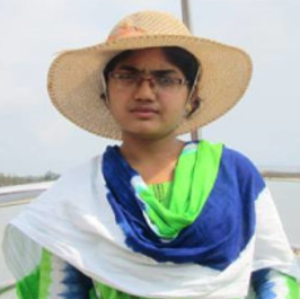Title : Three new species and one new record of Sillaginids (Perciformes: Sillaginidae) from Bay of Bengal, Bangladesh
Abstract:
Study on Sillaginids was conducted from October 2018 in the coastal region of the Bay of Bengal, Bangladesh. Four hundred and seventy-three individuals of 5 species of family Sillaginidae under two genera (Sillaginopsis and Sillago) were collected from 8 different landing stations of Bay of Bengal, Bangladesh namely Cox’s Bazar (BFDC), Kuakata, Mangroover forest Sunderbans (Dublarchar), Bhola (Ghosher hat), Maheshkhali, Patharghata (BFDC), Saint Martin’s Island, Shyamnagar (Kall bari). Morphological characters and DNA barcoding approach by partial mitochondrial cytochrome oxidase I subunit (COI), 12S rRNA, 16S rRNA, and Cytb were used to confirm their identification. However, these methods confirmed the misidentification of Sillago sihama in the Bangladesh sea area and identified three new species of Sillago. Furthermore, the first national record of Sillago soringa and re-description of Sillaginopsis panijus were also studied. Sillago soringa was only collected from the Saint Martin’s Island as well as Chennai, India. The distinctive characteristics of Sillago sp.1 from known Sillaginids are X-XI spines in the first dorsal fin; I, 20-22 rays 2nd dorsal fin; II, 21-23 rays anal fin; 68-72 scales in lateral line; 4-6/10-13 scales above/below lateral line; 3-5+8-10=11-14 gill rakers first arch; 12-14+5-8+12-15=32-35 vertebrae; body greenish dorsally, yellowish ventrally and swim bladder short and broad with two anterior extensions, two posterior extensions with lacuna at the base, anterolateral extension extends into anterior short, blind tubule and posterior one kinked, long and about half length complex towards the beginning and 8-9 lateral processes (anterior 2-3 stout and horn-like, posterior 6-7 rather small and triangular). Sillago sp.2 can be identified from Sillago sp.1 by swim bladder that is long with two anterior extensions; two posterior extensions without lacuna at base; anterolateral extension extends into anterior short, blind tubule and posterior one kinked, long and thin; 9-10 lateral processes (anterior 3-4 stout and horn-like, posterior 5-6 rather small and triangular) along with other meristics characters. Sillago sp.3 can be easily identified from the former two by only light yellowish or whitish anal fin. S. soringa can be identified from the former three by transparent pectoral and pelvic fins. Sillaginopsis panijus distinguished from others by 2nd dorsal fin spine very elongated, eyes small and swim bladder absent. The mean genetic divergences of COI for the intraspecific level were 0.2%, 0.1%, 0%, and 0% for S. sp.1, S. sp.2, S. sp.3, and Sillaginopsis panijus respectively. Mean genetic divergences of COI for the interspecific level ranged from 3.8% to 25.5% between S. sp.1, S. sp.2, S. sp.3, Sillaginopsis panijus, and other 13 Sillaginids species. Furthermore, mean genetic divergence of 12S rRNA for the intraspecific level ranged from 0% to 1.2% and for the interspecific level ranged from 1.9% to 26.8% for the studied species included related 16 species downloaded from GenBank. This study increased the number of known species of Sillago in the world and extended the distribution of S. soringa from Visakhapatnam, Chennai, India (Eastern Indian Ocean) to the Northeastern part of the Bay of Bengal, Bangladesh.



